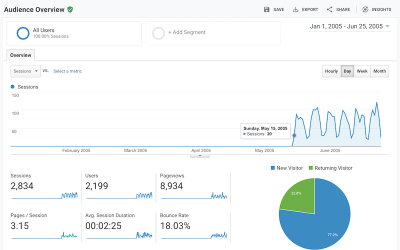[Updated May-2015] As anyone who has looked at the plethora of web metrics data available knows, even for a moderately active website, segmentation is the key to gaining insight. It allows you to group similar visitors e.g. customers, subscribers, contributors, engagers etc. together for comparison. Therefore instead of viewing metrics that are average of averages, the numbers actually mean something.
For example, quoting the Average Order Value for all customers is pretty meaningless. Knowing that the Average Order Value for visitors that have downloaded your PDF catalogue is twice that as people who haven’t, is a KPI that values your digital collateral. It allows you to make informed decisions about its prominence, content, update frequency, cross-sell and up-sell opportunities.
[ After defining and configuring goals, I view segmentation as your next most important step for your best practice web analytics setup. ]
Segmentation is important – no, critical. So what options are available?
Within Google Analytics, there are 3 ways to segment your visitors:
- As you drill down through your reports (clicking on data links)
- Using View (profile) filters to provide a dedicated View
- Using Advanced Segments
Drilling down into your data is intuitive and self-explanatory and happens as you navigate through your reports. However, what can cause confusion are the options available to you using 2 and 3 – View Filters or Advanced Segments.
View Filters and Advanced Segments are complementary features. Often I use both, first discovering segments within reports using the Advanced Segments menu. This is a quick and efficient method, because I segment the data immediately and can look back at historical data using the same segment. Then if required, I use View Filters to create dedicated report sets just for that segment.
I consider View filters a longer-term segmentation technique—a permanent way of segmenting visitors. Though View filters can be changed or removed at any time, the main difference is that once data is segmented out for example, removing the filter does not restore historical un-filtered data—the removed segment is permanently lost.
Advanced segments on the other hand, allow you to apply and remove segments without removing data. The table below compares the usage of each and suggests when one method may be more appropriate than the other.
Table: Comparing Advanced Segments versus View Filter uses
|
Advanced Segments |
View Filters |
|
Modify a report view at the visit or visitor (human) level. |
Modify incoming data at the pageview i.e. hit level to create separate Views (report sets). |
|
Applied to current and historical data. |
Applied only to new data from the time the filter is created. |
|
Instantaneous results—once they’re created, you can view segmented data in your reports immediately. |
Aimed at longer-term usage where once set, the segment is unlikely to change. |
|
Allow the use of conditional values on metrics, for example, greater than, less than. |
Only text string matches (dimensions) can be included—no numerical conditionals are available. |
|
Set up by report users, making them safe—no data can be lost or corrupted. |
Set up by administrators, as data can be permanently deleted or corrupted. |
|
Test facility available. |
Take 3–4 hours for data to populate reports. |
|
Combine statements to meet multiple conditions and sequences e.g. if user did X, then immediately did Y. |
Use cascading filters for combination effect. However, not as powerful as segmentation options. |
|
Configured on a per-user basis—segments can be shared with other report users, but cannot be used to hide data. |
Set on a per-View basis (report set), therefore access to segmented data can be controlled separately form other data. |
|
Regular expression statements are not limited, though the total combined for a segment with multiple statements must not exceed 30,000 characters. |
Regular expression statement limited to 255 characters. |
Summary for Choosing Advanced Segments versus View Filters
Use View Filters to remove “noise” segments from your reports, such as your own staff visitors or your agency, which can be excluded from your target audience. Apply View filters when the segment defined is a long-term one and unlikely to change—for example, your country offices wish to analyse only visits from within their region, or your support department wishes to focus only on helpdesk visitors. Use View filters when you wish to control the level of access, such as providing paid search data to an external agency.
Conversely, use advanced segments when you are drilling down to understand visitor behaviour, for example, comparing the performance of a particular marketing campaign against another, viewing mobile visitors versus desktop visitors, social network versus search engine visitors, or determining whether customers browse differently from non-customers. Apply advanced segments when you need to use conditional operators, such as visitors who spend more than 30 seconds on site or visitors who spend more than $100 per transaction.
As always, your feedback and comments are much appreciated.



Thanks for the post Brian,
One odd thing I am seeing (when I compare a Tablet filtered profile with a tablet segment); all the metrics on Audience overview are the same, except unique visitors (where there is about 16% more unique visits in the filtered profile.
Any idea on this?
Well I just learnt something new – the differences between advanced segments and filters. Thanks a lot for your article!
Hi Brian,
Thank you for explaining the advanced segments function in GA. I wasn’t aware of the pros and cons to this function yet, but I have been using filters. Based upon your concise summary, segments do have some clear advantages, and I like not losing data as you can with filters. As I’ve read online (and believe), it’s easy to gather statistics, but making any sense from it is entirely different. Segments seem like a good way to go.
Michelle
Brian, in your book, you say “At very least you should apply [include only your website’s traffic] filter to all your profiles.” Why would any other traffic be included?
Hi Brian,
We thought this was a really good blog post – so good, in fact, that we referenced it in our post entitled “9 resources explaining when to use segmentation or filters in Google Analytics”. You can find the post at http://analytics.bimehq.com/ if you’re interested to read it!
Thanks for detailing advanced segments feature in google analytics brian.
It’s not easy explaining detailed topics in a short post. Thank you Brian for taking the time to be clear and short. And thank you for answering this question before I even knew I was going to ask it 🙂
Thanks for the tip. Prior to reading this post I never really gave any thought to the idea that the day of the week as well as the time effected Ad-words based conversion rates.
Hi, I found the information on phone-users interesting. I believed for a very long time that one of my readers was using desktop, and it now turns out she has been using phone all the time. What surprised me was that her reading was counted all the time with me only checking “all visits” instead of looking particularly for phone-visits. Thank you!
Those are great ideas. There has been much discussion among some friends re: how to give other GA users access to segments. Opinions range from a segment manager, similar to the filter manager, to some type of social network for sharing advanced segments.
Hi Brian,
great summary!
Would you agree that, in short, filters are here to maximize data cleanliness and relevance prior to using segments?
Julien: That’s probably the most common usage for the majority of users. However, for large organisations I also use Profile Filters to split out sections of a website so that the stakeholders for a particular department only view data relevant to them.
For example, filters for UK only visits, US only visits, HelpDesk only, productA only, subscribers only etc. Historically I have used _setVar for this though now the new Custom Variables is the way to go as it gives you much more flexibility.
Also, profile filters give you access control e.g. show my only Adwords data to my PPC agency, which Adv. Segments do not.
Hi, Brian. I agree that advanced segments is great feature, and I often use it for data quick data mining and research.
But there is one thing stops me to feel full power of the segments. That is sampling, site I’m watching has a huge traffic so GA uses the sampling on a periods more than few days.
Google states that sampled reports has confidence level 95% but there are reports that definitely should have 100% confidence level on any period range e.g. direct traffic segment on direct traffic report. But in real life I see that segmented data differs from the real values sometime in 100%. That discourages me from full using advanced segments due to the I don’t know how much I could trust to the sampled segmented reports.
Could you please put some light on the GA data sampling in future posts?
I guess nobody is better suited to explain the differences between advanced segments and filters. Thanks a lot for your article.
The most important thing one should know when working with them is that filters work on page view level and advanced segments on visit level. Not keeping this in mind can create big headaches 🙂
Claudiu: That’s a very good point to emphasize. The first point in my table should be double under lined!